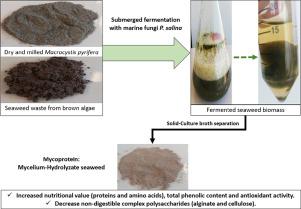Algal Research ( IF 4.6 ) Pub Date : 2020-12-04 , DOI: 10.1016/j.algal.2020.102135 Catalina Landeta Salgado , Rosa Muñoz , Adriana Blanco , María Elena Lienqueo

|
In this work, we have valued and increased the nutritional value of Macrocystis pyrifera and seaweed waste from brown macroalgae through a submerged fermentation process with the marine fungus Paradendryphiella salina. The product resulting after fermentation, the mycelium of P. salina together with the hydrolyzed algal, is called mycoprotein. We analyze the nutritional composition (carbohydrates, protein, amino acids, total fibre, caloric energy, fat), phenolic compounds and antioxidant activity in vitro of the mycoprotein obtained and of the algal biomass before fermentation. The content of total protein increased ~141% in fermented M. pyrifera and the total amino acids increased 73,5%. While that in fermented seaweed waste the protein increased ~131%. Furthermore, the fermentation on M. pyrifera and seaweed wastes had a positive effect on total carbohydrate reduction of this biomass algal ~38% and 35%, respectively. The concentration of the main complex polysaccharide presents in M. pyrifera, the alginate, was decreased significantly (up to 1.5-fold). In contrast, the cellulose concentration in fermented seaweed waste was significantly lower than the unfermented seaweed (up to 2.9-fold). According to these results, fermentation seems to enhance the nutritional value of seaweed biomass, and its potential is compared with Quorn, the mycoprotein used in food. Additionally, the total compounds phenolic and the antioxidant activity of fermented seaweed biomass exhibited an increase significantly face the unfermented seaweed biomass. Fermented seaweed waste resulted in the highest value of total phenolics and higher antioxidant activity, with an increase of 180.9 and 86.3%, respectively. Finally, this work shows that P. salina can assimilate brown macroalgae and even wastes of this biomass and produce mycoprotein like a promising strategy, and that may be useful food or functional food and feed.
中文翻译:

利用海生真菌Paradendryphiella salina生产霉菌蛋白来平衡和提升海藻和海藻废物的营养价值
在这项工作中,我们通过与海生真菌Para dendryphiella salina一起进行的水下发酵过程,珍视并增加了褐藻中的巨噬藻和海藻废物的营养价值。发酵后产生的产物,盐沼毕生菌丝体和水解的藻类,被称为真菌蛋白。我们分析了获得的霉菌蛋白和发酵前藻类生物质的体外营养成分(碳水化合物,蛋白质,氨基酸,总纤维,热量,脂肪),酚类化合物和抗氧化活性。发酵的毕赤酵母中总蛋白质含量增加了约141%总氨基酸增加了73.5%。而在发酵海藻废料中,蛋白质增加了131%。此外,在黄萎病菌和海藻废物上发酵对这种生物质藻类的总碳水化合物减少分别有约38%和35%的积极影响。萤火虫中主要复合多糖的浓度,海藻酸盐,显着下降(高达1.5倍)。相反,发酵海藻废料中的纤维素浓度显着低于未发酵海藻(高达2.9倍)。根据这些结果,发酵似乎可以提高海藻生物质的营养价值,并将其潜力与食品中使用的霉菌蛋白Quorn进行了比较。此外,面对未发酵的海藻生物质,发酵海藻生物质的总酚类化合物和抗氧化活性显着增加。发酵海藻废料的总酚含量最高,抗氧化活性更高,分别增加了180.9%和86.3%。最后,这项工作表明P. salina 可以吸收棕色大型藻类,甚至吸收这种生物质的废物,并产生微生物蛋白,这是一种很有前途的策略,可能是有用的食品或功能性食品和饲料。











































 京公网安备 11010802027423号
京公网安备 11010802027423号